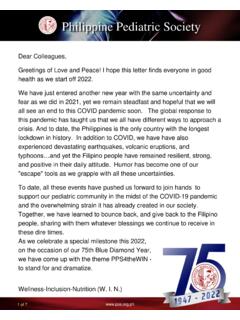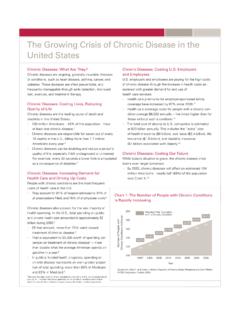Transcription of Another perfect storm? - IPES food
1 Another perfect STORM? How the failure to reform food systems has allowed the war in Ukraine to spark a third global food price crisis in 15 years, and what can be done to prevent the next one A special report by IPES-Food, May 2022. TABLE OF CONTENTS. 1. A rapidly unfolding food security crisis 2. 2. Four structural weaknesses that are leaving food systems vulnerable to price shocks 4. Food import dependencies 5. Path dependencies in production systems 8. Opaque, dysfunctional, and speculation-prone grain markets 10. Vicious cycles of conflict, climate change, poverty and food insecurity 15. 3. The dangers of ignoring the structural flaws and adopting short-sighted solutions 17. 4. Avoiding the next perfect storm': actions that can address immediate needs and kick-start food system transformation 20. SUMMARY. This Special Report takes stock of the impacts of the Ukraine crisis on global food security.
2 It identifies underlying vulnerabilities and rigidities in terms of food production patterns and import dependencies, in a context of declining international solidarity and systematic climate- induced supply strains. It also identifies grain hoarding and commodity speculation as key factors in turning the current shocks into a full-blown food price crisis . A number of these structural weaknesses were already identified following the 2007-2008 food price crisis , but were essentially left unaddressed. The Special Report warns against opportunistic and short- sighted responses to the crisis , including backsliding on food system reform commitments. It calls instead for urgent action to: support food importing countries (including through debt relief); tackle commodity speculation and enhance market transparency; reduce reliance on fertilizers and fossil energy in food production; accelerate the development of regional grain reserves and food security response systems; and diversify food production and restructure trade flows.
3 Although the Special Report does not discuss in detail the critical food security situation within Ukraine or in the world's many conflict zones, it highlights the vicious cycles of climate change, conflict, poverty, and food insecurity that are leaving millions of people highly vulnerable to shocks. This makes it all the more critical to act now to rebuild food security on a new and lasting basis. Failure to do so means sleepwalking into the catastrophic and systematic food crises of the future. 1. A rapidly unfolding food security crisis With spring crop planting down by at least a third, supply routes heavily disrupted by fighting, and over 10 million people now displaced, the Ukrainian population is facing dire food security threats in the wake of Russia's invasion. As in the world's many conflict zones . Yemen, Afghanistan, Syria, Ethiopia, and across the Sahel hunger is a systematic consequence of violence.
4 The war in Ukraine is also having major impacts on global agri-food markets, thanks to the disruption of Ukrainian and Russian grain exports. Supply interruptions in the Black Sea region have combined with export restrictions imposed in 20 countries to create temporary 2. shortages, stalled shipments, and panic buying. The result has been dramatic food price spikes that are exacerbating hunger in many of the world's poorest and most vulnerable regions. Wheat export prices hit a 14-year peak in March, rising 20% above February prices;. meanwhile, maize hit its highest price levels since records began, as the invasion of Ukraine combined with poor harvest forecasts. On April 8, the UN Food and Agriculture Organization (FAO) registered a third consecutive record food price index, with prices 34% higher than a year previously. As this note was published (May 6), the FAO was expected to report Another month of record-breaking price spikes.
5 The situation could deteriorate further if the conflict affects the summer harvesting of Ukrainian wheat. Although some are optimistic about potential shortfalls being made up by other countries, with India already upping wheat exports, drought in a number of wheat producing countries is raising questions about their ability to buoy global supplies. global grain production could also be hampered by record spikes in fertilizer prices, following supply interruptions from Russia and Belarus. Over 30 countries depend on Russia and Ukraine for at least 30% of their wheat import needs, and at least 20 countries source over 50% of wheat imports from those two countries and are therefore highly vulnerable to price shocks and/or supply shortfalls. Almost 40% of total African wheat imports come from Russia and Ukraine. Grain from the Black Sea region accounts for a huge share of imports for Eritrea (100%), Somalia (>90%), and DRC (>80%).
6 Countries which are highly dependent on wheat for caloric intake, and reliant on imports to meet those needs, are particularly exposed to global grain price spikes. In Eastern Africa, as much as a third of average cereal consumption is from wheat/wheat products, 84% of which is imported, largely from Ukraine and Rising wheat prices have already caused the price of bread to nearly double in Sudan, and to increase by 70% in Lebanon. The cost of importing wheat has increased by 33% in Kenya and Egypt, with Cairo the world's largest wheat importer now requesting IMF assistance. Price shocks are rippling out well beyond those regions with global food prices pre-invasion already 20% higher than the previous year on the back of rising energy prices and shipping 1. In Egypt and Djibouti, wheat accounts for as much as 35% of caloric intake, and they are reliant on imports to meet 79% and 100% of needs, respectively.
7 3. costs, and sanctions contributing to global inflationary Price volatility is already spilling over into soy, maize, and rice markets as importers substitute one commodity for Another . FAO modeling suggests that in a severe shock' scenario, which is looking increasingly likely, the global number of undernourished people will increase by million in the short term (2022/23) including million in Asia-Pacific and million in Sub- Saharan Africa. Progress on reducing hunger has already been stagnating since 2014-2015, and went fully into reverse in 2020 as the pandemic drove hunger up by , leaving up to 811 million people undernourished. In 2021, 40 million more people than the previous year faced acute food insecurity, according to new data from the UN/EU-led global Network Against Food Crises. The current price shocks come on top of severe drought in the Horn of Africa, which has left 20 million people at the risk of starvation.
8 The Ukraine crisis therefore risks making rising global food insecurity into a lasting trend, further undermining hopes of eradicating hunger by 2030, a key milestone in achieving the UN Sustainable Development Goals (SDGs). 2. Four structural weaknesses that are leaving food systems vulnerable to price shocks It is clear, therefore, that the Ukraine crisis is sparking major disruptions in global agri-food markets and threatening access to food for millions of people. But was a global food price crisis and food security crisis the inevitable impact of this conflict? Below, we argue that a number of underlying rigidities, weaknesses, and flaws in global food systems are amplifying the effects of the Ukraine conflict on food security, including: 1. Food import dependencies 2. Path dependencies in production systems 3. Opaque, dysfunctional, and speculation-prone grain markets; and 4. Vicious cycles of conflict, climate change, poverty, and food insecurity 2.
9 Although sanctions have not been imposed on Russian exports of food or fertilizer, sanctions on energy and other sectors may have knock-on effects on the global economy. However, these impacts and their implications for food security are hard to isolate from the disruptions caused directly by the conflict, and from the food export restrictions introduced by some 20. countries. 4. These flaws were already visible in the 2007-2008 global food price crisis , the subsequent 2010-2012 price spikes, and in the 2020-2021 COVID-induced disruptions. The failure to reform food systems and address these flaws has left millions of people critically vulnerable to shocks, which are likely to mount and intensify over the coming years. Food import dependencies Much has been made of Russia and Ukraine's importance as global grain producers. But to understand why the current disruptions are having such acute outcomes, it is crucial to break down the figures.
10 A number of countries are highly vulnerable because of a double dependency: i) on imports of staple crops, and ii) on a handful of exporters for a high percentage of those imports. Ultimately, food import dependencies have arisen from changing dietary patterns, and notably a shift towards a handful of staple crops. By 1995, wheat, rice and maize just 3 of the 7,000 plants consumed by humans accounted for more than 50% of the world's plant- derived food energy intake. Consumption of these and other globally traded crop commodities rose faster than other foods as a share of national food supplies over the past 50. years. Access to these foods has helped to ensure food security, and in some cases to diversify diets particularly in urban areas in the Sahel and other global South regions. However, the focus on staple crops since the colonial period has also eroded traditional diets and left countries heavily reliant on imports for what are now their staple foods.




